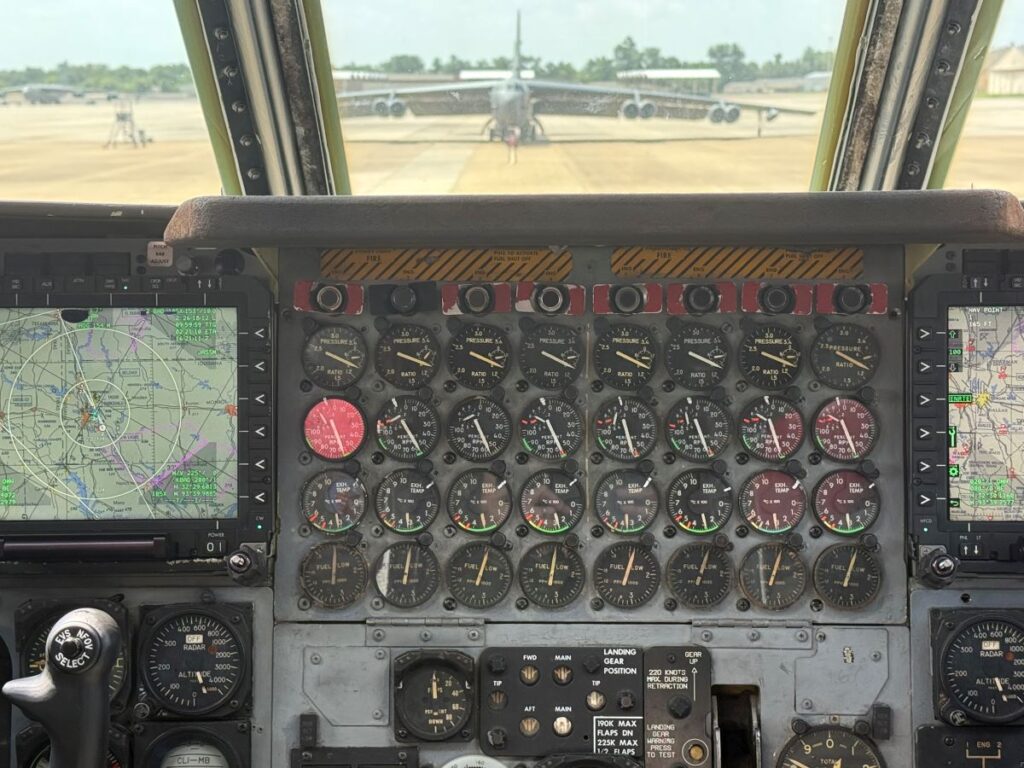
Pictured is a cockpit of a B-52H with the 93rd Bomb Squadron at Barksdale AFB, La. before take-off on June 17. The pilot’s and co-pilot’s Combat Network Communications Technology (CONECT) displays are at the sides of the photo.
BARKSDALE AFB, La.–Announced by Boeing in 2009 and first fielded in 2014, the company’s Combat Network Communications Technology (CONECT) upgrade for the B-52H has been to replace old displays and communications on the early 1960s bomber with such features as a moving map display in the cockpit and new displays at all crew stations, Link 16, and machine-to-machine beyond-line-of-sight tasking/re-targeting.
Yet, the effort is incomplete. B-52Hs with the 20th Bomb Squadron here, for example, are to be the first to receive Link 16 in a fleet wide effort over the next several years.
On a June 17 B-52H training flight, the two cockpit CONECT screens were working, but those at the other crew stations were not.
“Some of those [CONECT screens] have, over time, failed,” said Lt. Col. James Bresnahan, the commander of the 11th Bomb Squadron here. “We could pull those off of other aircraft, but now that aircraft has one or zero.”
CONECT allows bomber crews to plug in radios and mission equipment to display it in a moving map format that integrates off-board sensor and mission data.
In the last decade, B-52Hs have gotten the Joint Range Extension Applications Protocol (JREAP) to allow satellite data transfer over long distances and the Intelligence Broadcast Receiver (IBR) to permit the bomber crews to get radio-accepted global intelligence updates.
“Without that [JREAP and IBR], the B-52 had some roll-on systems we would carry on and plug in to get satellite updates but didn’t have a built-in design with the aircraft system to receive those updates,” Bresnahan said. “We went through a couple of iterations of that, of we gotta carry a suitcase on with a laptop, put a pseudo-antenna out the top of the airplane to get updates, and that was never integrated into [the bomber], fully supported, sustained, and developed whereas the JREAP, IBR and their CONECT framework has been fully supported and developed over time with limitations.”
Boeing has been the sole-source integrator for a wide array of B-52H modernization efforts, including internal weapons bay and communications network/electronics upgrades and a new active electronically scanned array radar based on RTX‘s APG-79.
The Air Force has said that the weapons bay upgrades would provide a 67 percent increase in smart weapons capacity.
The linchpin B-52H modernization thrust has been the Commercial Engine Replacement Program (CERP) to replace the plane’s eight Pratt & Whitney TF33-PW-103 engines, with more powerful Rolls-Royce F130s.
“Because of the long acquisition and fielding process, we’re lagging behind in the design stage all the way up to implementation,” Bresnahan said. “That’s definitely one of the challenges in fielding any of our new modernization [programs], CONECT being an example. When we’re looking at other big programs, those are being designed, planned and programmed now, but it’s gonna be five to 10 years before we implement so, just by nature of how that process works, we’ll be lagging a little bit behind and not have 2025 software and systems completely lining up with what is fielding today.”
Begun by the Air Force in 2013, B-52H Bomber Software Blocks (BSBs) are an effort to stay ahead of the curve and align software/hardware for such major programs as RMP and CERP. The current effort is BSB 7.2, and BSB 8 is to begin in the next two years.
The B-52H crew is to reduce from five to four, as the specialized electronic warfare officer (EWO)’s duties transfer to the other crew, including the weapons system officers below the cockpit.
“About 75 percent” of the EWO’s systems are “obsolete so we have started decommissioning a lot of the old systems,” Bresnahan said. “Only a few of the more modern systems remain that are directly connected to the defensive mission. There are some Air Force efforts to update and modernize those pieces of equipment, but those systems alone are not what we need for the complete defensive mindset and picture. At the [EWO] station and the other crew stations, we have CONECT interfaces so [the EWO] can take advantage of the other data fusion information we can receive to build the defensive picture.”
Another issue for B-52H crews has been the functioning of the mission data tape readers.
“We have two readers of the tape mission data,” Bresnahan said. “On most of the aircraft just one is functioning…One of them can get the job done, but, if both of those systems fail on the ground, we’ve gotta call out maintenance and get a replacement, and they may have to pull it off of another aircraft and put it onto ours to make it flyable. In flight, we can have a mission loaded with some capability, but certain failures may prohibit us from loading our mission data into weapons and fully getting the mission done.”
A version of this story originally appeared in affiliate publication Defense Daily.